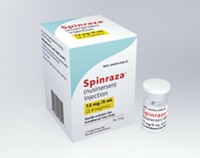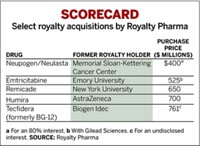Advertisement
Grab your lab coat. Let's get started
Welcome!
Welcome!
Create an account below to get 6 C&EN articles per month, receive newsletters and more - all free.
It seems this is your first time logging in online. Please enter the following information to continue.
As an ACS member you automatically get access to this site. All we need is few more details to create your reading experience.
Not you? Sign in with a different account.
Not you? Sign in with a different account.
ERROR 1
ERROR 1
ERROR 2
ERROR 2
ERROR 2
ERROR 2
ERROR 2
Password and Confirm password must match.
If you have an ACS member number, please enter it here so we can link this account to your membership. (optional)
ERROR 2
ACS values your privacy. By submitting your information, you are gaining access to C&EN and subscribing to our weekly newsletter. We use the information you provide to make your reading experience better, and we will never sell your data to third party members.
Business
Staying Alive
The biopharmaceutical sector scales back research to manage cash and ride out the economic downturn
by Rick Mullin
January 19, 2009
| A version of this story appeared in
Volume 87, Issue 3

WITH ITS heavy reliance on venture funding and other sources of capital that have recently and rapidly dried up, the biopharmaceutical industry is in a tough bind going into 2009. Several companies, in fact, are citing the economic downturn in decisions to cut back research and development and lay off staff.
Industry watchers agree that the sector, dominated by small companies yet to bring their first product to market, is retrenching under new economic pressure. Some see hard times as an opportunity for the industry to consolidate and emerge stronger, more focused, and with a better control of research spending. Others, though, foresee an inevitable loss of potential drugs accompanied by a loss of research talent as companies rein in spending.
Statistics recently published by the Biotechnology Industry Organization portray an industry in distress. According to the trade group, the number of initial public offerings (IPOs) in the sector in the first 11 months of 2008 dropped 97% compared with 2007. About 30% of all biopharmaceutical companies are now trading with less than six months of cash on hand, a 90% jump compared with 2007, and 45% of them have less than a year remaining, a 65% jump.
Biotechnology financing has also plummeted from about $44 billion in 2007 to $30 billion last year, according Burrill & Co., a San Francisco-based venture capital and merchant banking firm that specializes in biotech. The drop reflects the wider economic crisis and big shifts in capital markets that could lead to consolidation and other significant change for biopharmaceutical firms, according to G. Stephen Burrill, the firm's chief executive officer.
Venture capital firms with money to invest will be most interested in companies that have products in late-stage development, Burrill notes. They will be placing an emphasis on lowering risk, as will the biopharmaceutical companies themselves, given that their most important source of funding right now is the cash they have on hand.
Such a conservative approach means big changes for an industry in which companies are valued more for technologies and product pipelines than for revenue streams. A business model emphasizing risk abatement will naturally tend toward mergers and acquisitions, plus a heightened focus on licensing and partnerships, according to Burrill.
"In more fluid times, we created a lot more companies," Burrill says. "But not every piece of science deserves a company." He concedes that some projects may be postponed or dropped as companies shift their focus from technology to cash management. "It certainly won't accelerate the development of new drugs," he says. "But the health care sector continues to look at innovative products. There are still big opportunities for stronger companies to emerge and develop."
Greg Simon, president of FasterCures, a health care research advocacy group, agrees that the industry will manage to support development of significant new therapies in the months and years ahead by concentrating on the most promising ones. He says, however, that financial support for discovery will be harder to come by.
"It's sort of a last-dollar problem: Where are you going to spend your last dollar? You are going to spend it on stuff you already spent a lot of money on, moving it toward the finish line," Simon says. "The question, then, becomes, 'Where do you get the first dollar for new research?' " While therapies in late-stage clinical trials for marquee diseases such as Alzheimer's are fairly secure, he says, research in emerging areas such as personalized medicine and combined diagnostic and therapeutic medicines is at risk.
"In more fluid times, we created a lot more companies. But not every piece of science deserves a company."
GIVEN THE DIFFICULTY of securing traditional funding, Simon sees nonprofit and philanthropic organizations such as the Cystic Fibrosis Foundation and the Multiple Myeloma Research Foundation playing a greater role. "But this will not be enough to keep agile, risk-taking companies afloat," notes Simon, who has worked in recent weeks reviewing the Department of Health & Human Services (HHS) as a member of President-Elect Barack Obama's transition team.
Like Burrill, Simon predicts that more conservative risk management will lead to research cutbacks and consolidation. "There will obviously be some winnowing," he says. "It will force companies to figure out which are their best prospects, which is something they should do, but don't do when money is plentiful. They can never say goodbye to their molecule. Breaking up is hard to do."
The downturn means fundamental change for financing biopharmaceutical firms, according to George A. Scangos, CEO of Exelixis, a 15-year-old, publicly traded biotech company in South San Francisco. "For the majority of biotechs that don't yet have a product on the market, there are only a finite number of sources of money to run the business," he says.
For Exelixis, partnerships have played a significant role in amassing over $200 million of cash on hand, which, with committed funding, can fund the company's operations for the next three years, Scangos says. The firm currently has partnerships with Bristol-Myers Squibb, GlaxoSmithKline, and Daiichi Sankyo. High-quality drug candidates that can draw investment from large drug companies may be a key to survival, he says, though the trick is to be able to maintain equity in the partnered compound.
Although Exelixis' goal is to retain all the equity in its compounds if possible, Scangos notes that the economic downturn—Exelixis' stock has fallen to about $5.00 per share—will likely limit its ability to do so. "If our stock was sitting at $30 per share, we could go out and raise a couple hundred million and maybe we could partner one or two compounds fewer and develop them on our own," he says. "Maybe we'll sign partnership deals for one or two more compounds than we normally would, but it is not a fundamental shift for us. It's really a shift in emphasis."
In addition to raising cash, Scangos says, companies will need to manage what they have better. Exelixis is among the biotech firms that recently announced staff cuts, a 10% headcount reduction in its case. "Being smart about spending money and focusing on our key strengths and assets is part of getting through this environment in a thoughtful way," he says.
Other firms have made far deeper cuts in recent weeks. Avigen, for example, cut more than 70% of its staff, dropped work on a leading drug candidate, and sold another, with the intent of focusing entirely on finding a partner for its most promising compound, AV411, a neuropathic pain treatment.
Michael D. Coffee, chief business officer of the Alameda, Calif.-based firm, says the economic downturn is one factor, although a significant one, in recent decisions. "The world is cyclical," Coffee says, "and companies have their own ups and down." Avigen, formed in 1992 to develop gene therapy for hemophilia and Parkinson's disease, has been through this before. It reduced its staff by nearly 80% to 40 in 2005, shifting its focus to developing small-molecule drugs for neurology and pain management.
The company completed two rounds of financing by 2006, raising $52 million, and turned its attention to its lead candidate, AV650, a neuromuscular treatment. "But we knew that there was a possibility that we could get negative clinical data," Coffee says. "And that happened right in the middle of a maximum credit crisis."
Avigen announced in October that Phase II data in a trial for the treatment of spasticity associated with multiple sclerosis did not achieve its statistical endpoints. Staff cuts and the sale of a third program, a hemophilia compound called AV513, came shortly afterward.
Coffee says Avigen, now with 10 employees, has $56 million in cash and the basic infrastructure in place to pursue future projects. The company has shifted its focus to mergers and acquisitions—either acquiring a company with a late-stage candidate or being acquired, Coffee says.
At Cambridge, Mass.-based CombinatoRx, which recently announced a 65% staff reduction, efforts to manage cash have a new urgency, says Robert Forrester, chief financial officer (CFO). "We have cut back tremendously and reduced our burn rate to the point at which we have cash that will last us for four years," he says. The firm, which develops drug combination therapies, has $69.5 million in the bank. The downside, he says, is that the company will invest less and at a slower rate in people, products, and technology, he says.
"The concentration on cash management is not new, but it has been taken to a new level," Forrester says. "We might be keener to partner than we were before, and we might do it earlier than we had done it before. But it's not a fundamentally dramatic change."
BioCryst Pharmaceuticals, based in Birmingham, Ala., made a more modest cut, about 10% of staff to 79, to focus on its two lead candidates: peramivir, an influenza drug for which the firm has $102 million in funding from HHS, and forodesine, an oncology treatment. The company has partnerships with Shinogi on peramivir, and Mundipharma for forodesine.
"The mantra of the management team is to spend on appropriate things," says CFO Stuart Grant. He says the firm currently has a cash runway well into 2010.
Grant, the former CFO of Serono, says he is not concerned that projects put on hold or dropped by cash-starved biotech companies will cut patients off from potential therapies. "The smart programs will continue to be invested in. Companies will bring products to market," he says. "We are light enough as an industry to react quickly and focus energy and resources on programs that matter. There is a lot of cash at big pharma, and they will use it smartly. Deals will be done, partnerships struck, efficiencies looked for."
Forrester is a little less confident than Grant. "The cynical man on the street will say, 'There are too many biotech companies, too many clever ideas. They can't all be brilliant, therefore the really brilliant ones will survive,'" he says. The problem is that the crisis is deep enough that even some good ideas won't make it. "There is a fundamental problem: It's very hard to pick what is a good idea, which is why these companies exist in the first place," Forrester observes.
PTC THERAPEUTICS is among the biopharmaceutical companies that have not announced cuts in staff. In fact, the company is expanding its facility in South Plainfield, N.J., according to CFO Chip Baird. "We have $400 million in the door," Baird says, noting that the company raised $132 million though a series of venture capital funding rounds between 2000 and 2005. In 2006, he says, it began pursuing partnerships, landing its first with Schering-Plough for a hepatitis therapy that brought $12 million up front with $200 million in potential milestone payments.
PTC also has deals with Pfizer, CV Therapeutics, Celgene, and Genzyme, the latter on PTC 124, its lead compound, for Duchenne muscular dystrophy. That deal, for which PTC received $100 million up front, would give Genzyme rights to the drug outside the U.S. and Canada.
The company has also received grant commitments totaling $85 million, including grants from the National Institutes of Health, the Department of Defense, and the Cystic Fibrosis Foundation.
Baird says his key focus is cash "in the door." "People always talk about the bio dollars—bio bucks—and we certainly can do that too," Baird says, referring to milestone payments and royalties that a company may never receive. "But in terms of cash in the door, we received over $180 million and counting on these collaborations."
The company's success in forming partnerships for its gene expression modulation by small molecules (GEMS) technology figured in its decision to drop its filing for an IPO in 2006, according to Baird. He says the company has not ruled out another IPO filing if market conditions improve.
Despite its secure cash position, Baird says PTC is thinking about better managing its costs all the time. "We've gotten our vendors and partners in the development process to really sharpen their pencils," he says. "As a result of the economic environment, people are a little more willing to work with you on price."
Advertisement
The company is also bearing down on balancing time, money, and risk in research. "You can design the perfect study with belt and suspenders and make sure you are not missing any end points," Baird says. "But in this environment, you need to be more nimble with clinical design in order to better manage cash."
While company executives largely see their woes in a broader business cycle perspective, the consensus is that the severity of the current downturn is likely to be transformative.
"A different business model may emerge," Burrill says, "with more interest in risk abatement on technology and more partnering and licensing. Some might say, 'This too will pass, I just gotta hang out.' But I don't share that view. I think this is a fundamental restructuring of the world economy, and we will be going through it for three to five years."
More Online
Stay current on the chemical industry's responses to changing economic conditions by visiting www.cen-online.org/economy.
The restructuring will, at least for now, shift the balance between science and business toward business, with companies concentrating on managing their financial risk. Exelixis' Scangos is among those who see a resulting threat to progress toward treating unmet medical needs, the industry's raison d'Être.
"Today it would not be possible to start a company like Exelixis," he says. "There is a whole generation of companies—our generation—some of which will contribute major products that will go on to benefit patients. There is not a next generation of companies now being started. There is no way of making that economically sensible to investors. This will have a long-lasting impact on the biotech industry."








Join the conversation
Contact the reporter
Submit a Letter to the Editor for publication
Engage with us on Twitter